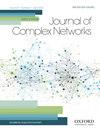多社区网络中传染病传播的峰值感染比例
IF 1.5
4区 数学
Q2 MATHEMATICS, INTERDISCIPLINARY APPLICATIONS
引用次数: 2
摘要
缓解大流行(如2019年冠状病毒病)全球传播的最有效策略之一是关闭国际机场。从网络理论的角度来看,这是因为国际机场和航班在整个多社区系统中主导着疫情的传播特征,本质上是作为个体社区的国家之间的桥梁节点和桥梁纽带。在所有流行病特征中,在医疗资源能力有限的情况下,感染高峰比例$I_{\max}$是评估流行病策略的决定性因素,但在多社区模型中很少考虑。本文研究了一类由部分桥节点$r$连接的一般双群落系统,特别是$I_{\max}$在易感-感染-恢复模型演化下的动态特性。通过比较系统不同部分的特征时间尺度,我们可以解析地推导出$I_{\max}$与$r$的渐近行为,因为$r\rightarrow 0$在相图的每个区域中遵循不同的幂律关系。当$I_{\max}$从一个幂律变化到另一个幂律时,我们也检测到交叉,在$r$的驱动下跨越不同的幂律制度。我们的结果能够更好地预测作用于桥节点的策略的有效性,用幂律指数$\epsilon_I$表示,如$I_{\max}\propto r^{1/\epsilon_I}$所示。本文章由计算机程序翻译,如有差异,请以英文原文为准。
Peak fraction of infected in epidemic spreading for multi-community networks
One of the most effective strategies to mitigate the global spreading of a pandemic (e.g. coronavirus disease 2019) is to shut down international airports. From a network theory perspective, this is since international airports and flights, essentially playing the roles of bridge nodes and bridge links between countries as individual communities, dominate the epidemic spreading characteristics in the whole multi-community system. Among all epidemic characteristics, the peak fraction of infected, $I_{\max}$, is a decisive factor in evaluating an epidemic strategy given limited capacity of medical resources but is seldom considered in multi-community models. In this article, we study a general two-community system interconnected by a fraction $r$ of bridge nodes and its dynamic properties, especially $I_{\max}$, under the evolution of the susceptible-infected-recovered model. Comparing the characteristic time scales of different parts of the system allows us to analytically derive the asymptotic behaviour of $I_{\max}$ with $r$, as $r\rightarrow 0$, which follows different power-law relations in each regime of the phase diagram. We also detect crossovers when $I_{\max}$ changes from one power law to another, crossing different power-law regimes as driven by $r$. Our results enable a better prediction of the effectiveness of strategies acting on bridge nodes, denoted by the power-law exponent $\epsilon_I$ as in $I_{\max}\propto r^{1/\epsilon_I}$.
求助全文
通过发布文献求助,成功后即可免费获取论文全文。
去求助
来源期刊

Journal of complex networks
MATHEMATICS, INTERDISCIPLINARY APPLICATIONS-
CiteScore
4.20
自引率
9.50%
发文量
40
期刊介绍:
Journal of Complex Networks publishes original articles and reviews with a significant contribution to the analysis and understanding of complex networks and its applications in diverse fields. Complex networks are loosely defined as networks with nontrivial topology and dynamics, which appear as the skeletons of complex systems in the real-world. The journal covers everything from the basic mathematical, physical and computational principles needed for studying complex networks to their applications leading to predictive models in molecular, biological, ecological, informational, engineering, social, technological and other systems. It includes, but is not limited to, the following topics: - Mathematical and numerical analysis of networks - Network theory and computer sciences - Structural analysis of networks - Dynamics on networks - Physical models on networks - Networks and epidemiology - Social, socio-economic and political networks - Ecological networks - Technological and infrastructural networks - Brain and tissue networks - Biological and molecular networks - Spatial networks - Techno-social networks i.e. online social networks, social networking sites, social media - Other applications of networks - Evolving networks - Multilayer networks - Game theory on networks - Biomedicine related networks - Animal social networks - Climate networks - Cognitive, language and informational network
 求助内容:
求助内容: 应助结果提醒方式:
应助结果提醒方式:


